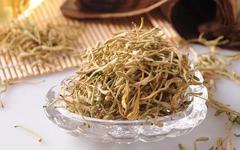Honeysuckle, originally named Jin Yin Hua, is the dried flower buds or early blooming flowers of the plant Lonicera japonica, belonging to the Caprifoliaceae family. The name “Honeysuckle” comes from the fact that the flowers are white when they first bloom and turn yellow later. Additionally, because it has two flowers on one stem, they appear in pairs, resembling mandarin ducks dancing together, hence it is also called “Yuan Yang Teng” (Mandarin Duck Vine). Therefore, Honeysuckle symbolizes beautiful love.
Since ancient times, Honeysuckle has been praised as an excellent medicine for clearing heat and detoxifying, earning the nickname “Little Immortal of the Pharmacy”. It is one of the commonly used Chinese medicinal materials in our country, with a long history of medicinal use.
The “Shen Nong Ben Cao Jing” records: “Honeysuckle is cold in nature and sweet in flavor, with the effects of clearing heat and detoxifying, cooling the blood and resolving stasis. It is used to treat external wind-heat, initial stages of pestilence, sores and carbuncles, redness, swelling, heat, and pain, as well as purulent blood in stools.” Because it can “clear heat and detoxify, prevent and treat pestilence”, Honeysuckle has played a significant role in the prevention and treatment of COVID-19, being included in many prescriptions published by provinces and cities across the country. Let us take a detailed look at the efficacy and functions of Honeysuckle.
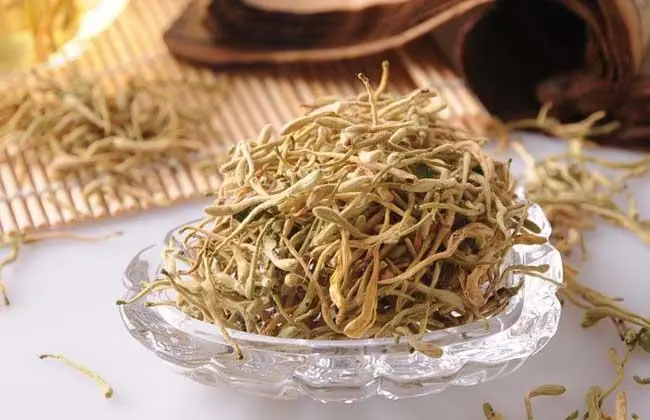
Honeysuckle is also known as Ren Dong Hua (忍冬花) (“Tang Ben Cao”), Yin Hua (银花) (“Wen Bing Tiao Bian”), Lu Ci Hua (鹭鸶花) (“Zhi Wu Ming Shi Tu Kao”), Su Hua (苏花) (“Yao Cai Zi Liao Hui Bian”), Jin Hua (金花) (“Jiangsu Zhi Yao Zhi”), Jin Teng Hua (金藤花) (“Hebei Yao Cai”), Shuang Hua (双花) (“Zhong Yao Cai Shou Ce”), Shuang Bao Hua (双苞花) (“Zhejiang Min Jian Cao Yao”), Er Hua (二花) (“Shaanxi Zhong Yao Zhi”), and Er Bao Hua (二宝花) (“Jiangsu Yan Fang Cao Yao Xuan Bian”). The medicinal part is the flower buds of the Lonicera japonica plant. The flower buds are harvested in the morning on sunny days in May to June when the dew has just dried, then spread out to dry or shade-dry, taking care to turn them over to prevent blackening. Avoid exposure to direct sunlight. It is best to store them in a dry, ventilated place to prevent insect infestation and discoloration.
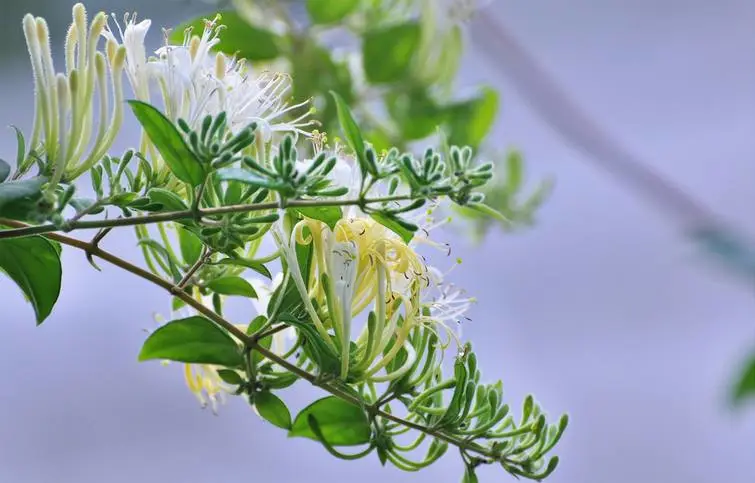
The plant morphology of Honeysuckle is a perennial semi-evergreen climbing woody vine, reaching up to 9 meters in length. The stems are hollow and branched, with young branches densely covered in short soft hairs and glandular hairs. The leaves are opposite; the petiole is 4-10 cm long, densely covered in short soft hairs; the leaves are papery, ovate, elongated ovate, or ovate-lanceolate, measuring 2.5-8 cm in length and 1-5.5 cm in width, with a short pointed, gradually pointed, or bluntly rounded apex, and a rounded or nearly heart-shaped base, entire margins, and both surfaces and edges covered in short soft hairs. The flowers grow in pairs in the axils, with flower stalks densely covered in short soft hairs and glandular hairs; the total flower stalk is usually solitary in the upper leaf axils of the branch, equal to or slightly shorter than the paired stalks, with those in the lower part measuring 2-4 cm long, densely covered in short soft hairs and glandular hairs; there are two bracts, leaf-like, broadly ovate or elliptical, about 3.5 mm long, hairy or nearly hairless; the small bracts are about 1 mm long, covered in short hairs and glandular hairs; the calyx is small, about 2 mm long, hairless, with 5 lobes, the lobes are ovate-triangular or long-triangular, pointed at the apex, and densely hairy on the outside and edges; the corolla is lip-shaped, 3-5 cm long, with the upper lip having 4 shallow lobes, the corolla tube is elongated, covered in short hairs and glandular hairs on the outside, the upper lip lobes are blunt at the apex, and the lower lip is strap-shaped and reflexed, initially white when blooming, turning golden yellow after 2-3 days; there are 5 stamens, attached near the mouth of the corolla tube, extending outside the corolla; there is 1 pistil, with a lower ovary, and a slender style extending out. The berries are spherical, 6-7 mm in diameter, and turn blue-black and shiny when mature. The flowering period is from April to July, and the fruiting period is from June to November.
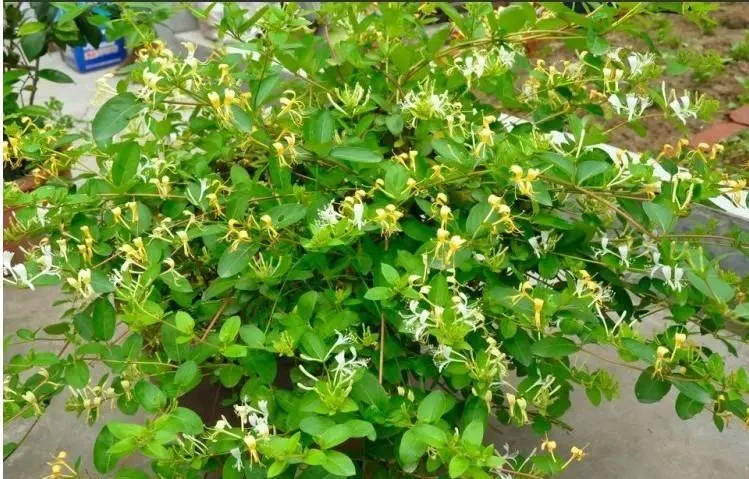
Preparation
1. Honeysuckle: Remove sand and impurities.
2. Charred Honeysuckle: Take the cleaned Honeysuckle, place it in a pot, and stir-fry over high heat until it turns dark brown, then spray with clean water, take it out, and dry it.
Meridian Affinity
Lung; Stomach
Nature and Flavor
Sweet; Cold
Precautions
Contraindicated for those with spleen and stomach deficiency-cold and qi deficiency with purulent sores.
Functions and Indications
Clears heat and detoxifies. Indicated for febrile diseases due to warm pathogens; heat-toxicity causing bloody dysentery; carbuncles and sores; throat obstruction and various infectious diseases.
Dosage and Administration
Internal use: decoction, 10-20 g; or in pills or powders. External use: appropriate amount, crushed and applied.
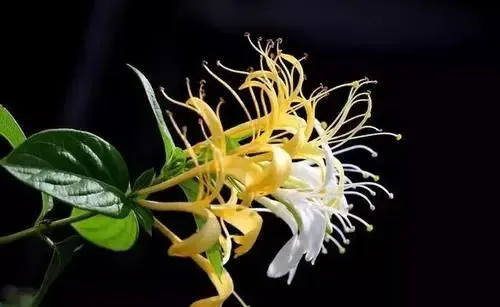
The Efficacy and Functions of Honeysuckle
1. Antibacterial and Anti-inflammatory: Honeysuckle contains various natural antibacterial components that can prevent the proliferation of bacteria in the body, thus exerting antibacterial and anti-inflammatory effects.
2. Clears Heat and Detoxifies: Prevents excessive internal heat. Honeysuckle is a cold and cool medicinal material, making it very effective in clearing heat and detoxifying, making it suitable for those with mouth sores, excessive internal heat, and sore throats.
3. Beauty and Skin Nourishment: Honeysuckle can nourish the skin and lighten spots, making the skin fair and refined. However, it is not suitable for everyone; those with spleen and stomach deficiency-cold, frequent diarrhea, or cold hands and feet should be cautious. It is best to avoid consumption during menstruation, as it may cause excessive internal cold.
4. Enhances Immunity: Honeysuckle helps promote lymphocyte transformation and enhances the phagocytic ability of white blood cells.
5. Lowers Blood Lipids: The active components in Honeysuckle can combine with cholesterol, reducing its absorption in the intestines, thereby lowering cholesterol levels in the blood. Drinking it as tea can also help the body eliminate harmful substances from the blood and increase blood flow in the vessels, preventing cardiovascular diseases.

Contraindications for Honeysuckle
1. Pregnant and breastfeeding women should avoid consuming Honeysuckle. Due to their special physiological state, they require special care and management. Although Honeysuckle is a natural herbal material, some of its components may adversely affect the fetus or infant, potentially causing miscarriage or lactation issues. Therefore, to ensure the health of both mother and child, it is best for pregnant and breastfeeding women to avoid consuming Honeysuckle.
2. Individuals with spleen and stomach deficiency-cold should avoid Honeysuckle. As it is a slightly cold herb, this group may experience adverse reactions such as abdominal cold pain, diarrhea, and vomiting.
3. Individuals prone to allergies should also avoid Honeysuckle. Some specific chemical components in Honeysuckle may cause discomfort in certain individuals, such as headaches, nausea, vomiting, and rashes.
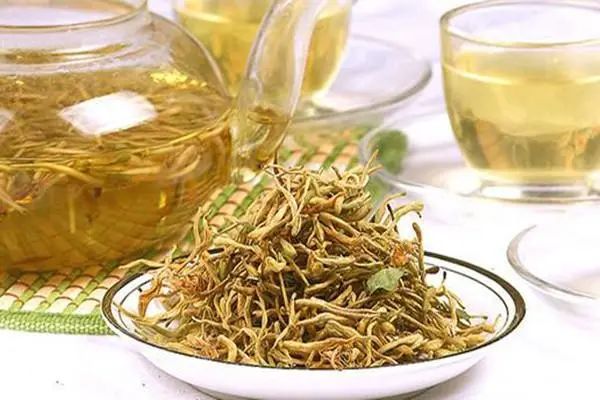
Selected Formulas
① Prevention of Japanese Encephalitis and Meningitis: Honeysuckle, Lian Qiao (Lonicerae Flos), Da Qing Gen (Isatis Root), Lu Gen (Phragmites), and Gan Cao (Licorice) each 9 g. Decoction as tea, one dose daily, for three to five days. (“Jiangxi Herbal Medicine”)
③ Treatment of Dysentery: Honeysuckle (roasted in a copper pot until dry) 15 g. For red dysentery, take with white honey water; for white dysentery, take with sand sugar water. (“Hui Zhi Tang Experience Formula” Ren Dong San)
⑤ Treatment of Biliary Tract Infections and Wound Infections: Honeysuckle 30 g, Lian Qiao, Da Qing Gen, Huang Qin (Scutellaria), and Ye Ju Hua (Wild Chrysanthemum) each 15 g. Decoction, one dose daily. (“Jiangxi Herbal Medicine”)
⑦ Treatment of All Tumors and Abscesses, regardless of whether they have ruptured or not, or initial fever, and carbuncles: Honeysuckle (with stems and leaves) half a bowl of natural juice, decoct to 80% and take, apply the residue externally, dispelling toxins and promoting blood circulation, with unique efficacy. (“Ji Shan Tang Experience Formula”)
⑨ Treatment of All Internal and External Abscesses: Honeysuckle 120 g, Gan Cao 90 g. Decoction and take immediately; those who can drink should take it with wine. (“Yi Xue Xin Wu” Ren Dong Tang)
⒀ Treatment of Early Acute Mastitis: Honeysuckle 24 g, Pu Gong Ying (Dandelion) 15 g, Lian Qiao and Chen Pi (Aged Tangerine Peel) each 9 g, Qing Pi (Green Tangerine Peel) and Sheng Gan Cao each 6 g. This is one dose, decoct twice, and take in two doses daily; for severe cases, two doses can be taken in one day. (“Zhong Ji Yi Kan” (3): 167, 1964)
⒂ Treatment of Yangmei Toxicity: Honeysuckle 30 g, Gan Cao 6 g, Hei Liao Dou (Black Soybean) 60 g, Tu Fu Ling (Smilax) 120 g. Decoction, one dose daily, must be consumed completely. (“Wai Ke Shi Fa” Ren Dong Tang)
⒃ Detoxification from Pesticides (organic phosphorus preparations 1059, 1605, 4049, etc.): Honeysuckle 60-90 g, Ming Fan (Alum) 6 g, Da Huang (Rhubarb) 15 g, Gan Cao 60-90 g. Decoction and take cold, one dose per time, two doses daily. (“Xuzhou Selected New Medical Methods”)

Note:This account aims to promote traditional Chinese medicine culture. The TCM knowledge mentioned in the text is for learning and communication purposes only.
WeChat has been updated! If youneither★starred me,nor liked or “viewed” my articles,the system will assume you do not wish to receive information related to herbal medicine knowledge, and ultimatelyyou will not receive our article updates.
End of the article. Thank you for your patience in reading. If you find it interesting, please click “ like” and “
like” and “ view”.~
view”.~

